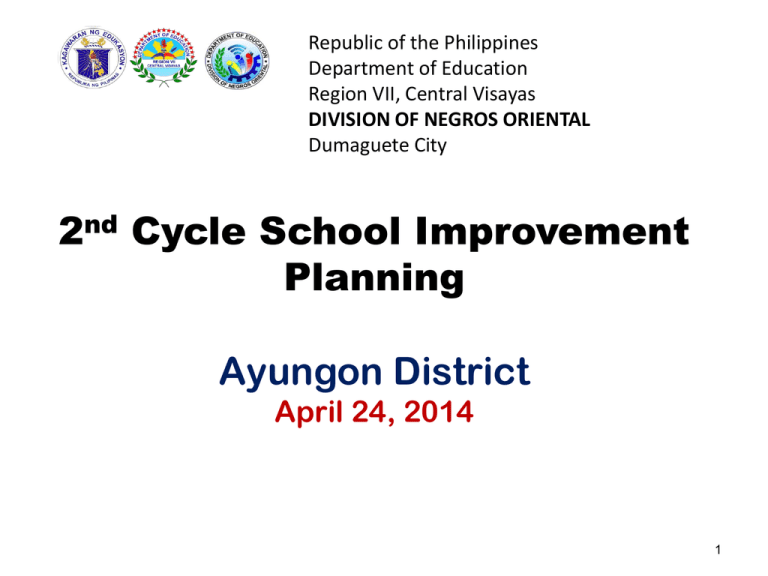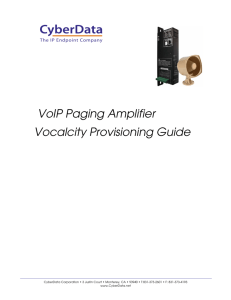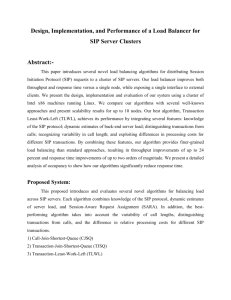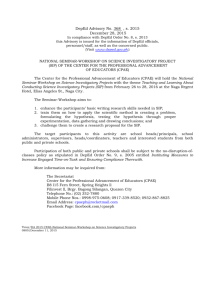School Improvement Planning: Ayungon District, Philippines
advertisement

Republic of the Philippines Department of Education Region VII, Central Visayas DIVISION OF NEGROS ORIENTAL Dumaguete City 2nd Cycle School Improvement Planning Ayungon District April 24, 2014 1 To improve is to change. To be perfect is to change often. o Winston Churchill Rational Objectives: • Enhance knowledge on the content and process of SIP • Make a clear understanding of SIP implementation 3 Experiential Objectives: • Realize the value of cooperation for greater success of SIP preparation. • Be anticipative about immediate actions to be done. 4 Activity 1. What are the parts of the SIP? (outline only) 2. What are the processes in the development of the SIP? 3. Why do schools prepare SIPs? R.A. No. 9155 – Chapter 1, Section 7 Consistent with the national education policies, plans and standards, the school heads shall have authority, accountability and responsibility for the following: 1.Setting the mission, vision, goals and objectives of the school 4. Developing the school education program and school improvement plan 6 Quality Management System Some Core Principles in School Improvement: • It is based on standards. Standards must be set to create high expectations for the school. • It is learner-centered. All improvements are for the holistic development of learners. School planning, fund sourcing, physical improvement, and policy formulation are done with the learners’ welfare foremost in the mind of stakeholders. • It is participatory. To develop a sense of ownership, it is important that stakeholders are part of the school improvement process from the planning, implementing up to the monitoring , evaluation and reporting . • It is based on hard data. Effective schools make decisions based on accurate, reliable and analyzed data. • It is systematic. Schools make use of short-term strategies as part of a larger long-term effort and lasting systemic change that is why schools have an AIP based on their SIP. They prioritize school improvement that is likely to have the greatest impact on learners’ learning and development. • It is systemic. The improvement process is not only on one part of the school system. Rather it includes the entire school system (leadership, curriculum and instruction, learning environment, schoolcommunity relations, resources, etc.) to institute a change of school culture. • It is continuous. There is no end to school improvement for there will always be a room for improvement. A key reform thrust in the DepED is to get all schools continuously improve. • It is logical and iterative. School improvement gives the school community an opportunity to reflect on their school in the past school year/s, assess results, plan and project a future characterized by improved performance. • It is inclusive and integrative. It includes the regular programs of the school and integrates national policies (DepED/DBM/COA/CSC, etc.). Guiding Principles: 1. The SIP shall be anchored on the DepEd Vision, Mission and Core Values; 2. The SIP shall be results-based, child and learner-centered 3. The planning process shall be participatory, engaging various stakeholders in the processes of dialogues and consensus-building OUTLINE: I. Vision, Mission and Core Values II. Objectives and Targets III. Situational Analysis a. Situation of Children/Learners b. Environmental Scan I. External Analysis II. Internal Analysis IV.Strategies V. Action Plan VI.Monitoring & Evaluation Arrangements Major focal areas where decisions need to be made: 1. Delivery of Services for Basic Education 2. Organizational Health/Performance. 17 Curricular Programs & Projects Education Resources Delivery of Services for Basic Educatio EduEducation School Teacher Performance Learner Performance M&E Content Areas School Management Organizational Health & Performance Productivity Community Partnership 18 A. Delivery of Services for Basic Education A.1. Curricular Programs and Projects concerned with obtaining information on the efficiency and effectiveness of the implementation of curriculum programs and projects which is the core business of schools. 19 DepED programs: • • • • • Brigada Eskwela Every Child A Reader Program (ECARP) Child -Friendly School System (CFSS) Early Childhood Care Development, National Elementary/Secondary Press Conferences, DepED programs: • • • • Dropout Reduction Program (DORP) School Feeding Program Oplan Balik-Eswela Mother Tongue-Based Multilingual Education • Use of Alternative Delivery Modes of Education DepEd Programs: • Culture-responsive Curriculum for Indigenous Peoples • Gender and Development • Disaster and Risk Reduction Program • National Greening Program A.2. Education Resources - concerned with accessibility, adequacy, equitable distribution, and maintenance of resources required to efficiently deliver basic education. 23 SCHOOL RESOURCES would include ascertaining the optimal application/utilization of the following (but not limited to): Funding Requirements for School Operations (MOOE, SEF, PTA and other sources) Number of Teachers Learning and Instructional Materials/Resources (textbooks, manuals, learning equipment, etc.) Physical and Ancillary Facilities 24 A.3. Teacher Performance – concerned with monitoring and evaluating teaching-learning practices of teachers, particularly on the following: Instructional Delivery Utilization of Instructional Materials Classroom and Record Management Involvement in School-Community Activities Personal growth and professional development 25 A.4. Learner Performance – concerned with getting information on the learners: school attendance, academic achievement participation in co-curricular activities 26 B. Organizational Health and Performance B.1. School Management – focused on monitoring and evaluating the efficiency and effectiveness of the implementation of plans for school improvement. Specifically, it is concerned with the following: SIP Implementation Instructional Supervision Staff Development 27 B.2. Productivity – concerned with the work outputs of the individuals based on their specific job descriptions, i.e., support staff, utility. This may also be concerned with team or committee outputs based on their terms and reference, i.e., SGC, PTA, SQMT, SIPIT, SPT, Special Program Committees, PGO/SSG, etc. 28 B.3. Community Partnership - focused on how school stakeholders are engaged in school activities including its level and quality of participation, e.g. parents, LGU, NGOs, alumni, etc. It is also concerned with the level of school’s participation in community-initiated activities. 29 School Improvement Planning is a process where teachers, parents, students and community leaders come together to analyze the status of their school, set their directions and define school improvement and monitoring plans which are focused on improving educational outcomes. These educational outcomes include the performance indicators and the holistic development and well-being of all learners. The result of School Improvement Planning is a School Improvement Plan (SIP) SIP is a road map that establishes the changes that the school needs in order to improve student achievement and that shows how and when these changes will be made. SIP is a three-year education development plan that embodies the vision and mission of Department that the school must embrace. SIP contains the profile of the school and the community, problems and needs, goals, objectives, standards and targets, implementation plan, monitoring and evaluation plan, communication and advocacy plan, documentation and reporting to stakeholders and signatories. • a comprehensive overview of major priorities to which the school will commit its resources including activities which are supportive of the • The ultimate objective of the school improvement process is to achieve the desired learning outcomes by enhancing the way curriculum is delivered by competent, committed and caring teachers by creating a safe and a nurturing environment for learning, and by increasing the stakeholders’ participation in the entire school improvement process. • It also aims to help school heads, teachers, parents and other stakeholders in the school community participate in a continuous improvement process by identifying potential barriers to improvement and by finding ways to move the school from where it is now to a condition in which students can achieve their highest potential. • The process primarily requires constant analysis of school needs, planning and implementing appropriate actions and monitoring and evaluating results and outcomes. • It also involves comparing existing school practices with those of others and obtaining information about best practices in order to raise standards and ultimately improve school performance. Timeline & Activities: The Planning Process 1. Preparatory phase involves convening of the School-Community Planning Team and data gathering, including the conduct of focused group discussions with parents and other stakeholders as necessary 2. Conduct of the SIP planning workshop this is done within a duration of three (3) days and consists of the following sessions: Opening and orientation on the DepEd vision, mission and core values Establishing the situation of children/learners and setting the objectives and targets Formulating strategies Preparing the Action Plan Closing session 3. Post-workshop activitiesthe finalization of the SIP Be guided by the Division Memorandum issued March 26, 2014 and April 4, 2014 Title: 2nd Cycle School Improvement Plan Launching in Schools of the Division of Negros Oriental and Its Minimum Requirements Title: Organization of Division/District/School SIP Review Team Step 1:Collecting, Organizing, and Analyzing School Data a) Data-gathering and organization b) data analyses and interpretation c) identification/verification of problems and their causes d) prioritization of problems e) selection of solution and strategies Step 2: Understanding the National Vision, Mission and Core Values Consider the 3Ps 1. Determining the School Goals & Objectives 3. Determining the School Goals and Objectives • The goal can target a content area: Example: All students in VSP School will show improvement in mathematics through increases in achievement in the school, division, region and national assessments. 4. Formulating the Work and Financial Plan and Annual Implementation Plan 5. Developing the School’s Monitoring & Evaluation Plan and Structure 6. Organizing for Implementation Ultimate objective of SIP To achieve the desired educational outcomes through the enhancement of curriculum delivery >by competent, committed and caring teachers >by creating a safe and nurturing environment for learning; and >by increasing the stakeholders’ participation in the entire school improvement process Convening the School-Community Planning Team (SPT) Composition: 1 school head 1 parent representative 1 student representative 1 teacher representative 1 community member 1 barangay official/LGU 1 member of the Disaster Risk Reduction Management Committee (DRRMC) Application (Working paper to help you in your planning): • Using the School Calendar SY 2014-2015, prepare the activities for the months. • In thee columns of the bond paper write the successful activities done in SY 2013-2014, activities you want to continue and activities you failed to accomplish which you need to do. We cannot hold a torch to light another’s path without brightening our own. o Ben Sweetland







